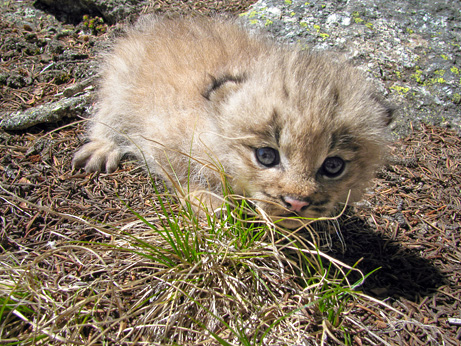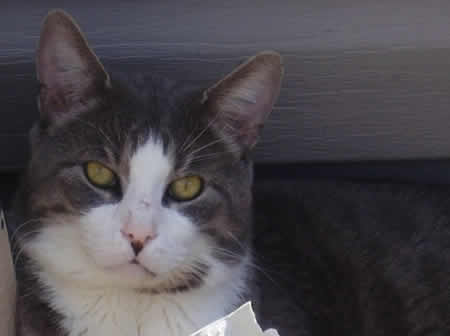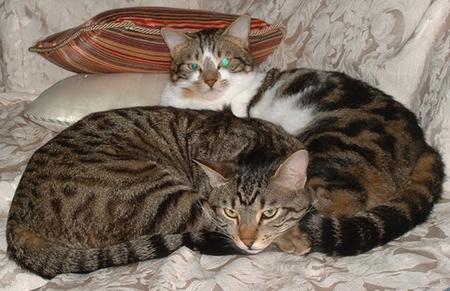Merry Christmas Folks and Moggies!
From, Ed and Oscar
x x x
The Foldex cat breed was established by cross breeding both Exotic Shorthair and Exotic Longhair breeds with the Scottish Fold breed – it’s distinguishing feature (which characterises the Foldex breed) is a highly rounded, gathered and folded pair of ears.
Cat of the Month ~ December 2017
The Foldex breed first appeared around 1992 in Quebec, Canada as an experimental breed. This cross breeding resulted is a new Persian type breed with folded ears. This animal made its first appearance in a show hall in 1993, being presented by Betty Ann Yaxley. On viewing and admiring this new feline Jeanne Barrette dedicated herself to work with this animal well into the future. Consequently the Foldex breed was accepted as an ‘Experimental Breed’ in November of 1998 and in August of 2006 it was accepted as a New Breed for championship (cat show) status. However it is only recognised by the Canadian Cat Association (CCA).
The Foldex breed has a shorter nose than the Scottish Fold breed. Their body type is sturdy and muscular with good bone structure, a stubby neck, round eyes and a round head that give the breed a very owl like appearance. The folded ears further make the cat a little like a small ‘teddy bear’. Fully grown the weight of this cat is around five to eight pounds. Coats are dense and soft to the touch and can be long or short. The Foldex breed comes in a large variety of colours and patterns.
If allowed to breed these folded ear cats must be crossed with a straight ear cat. This must be done to avoid the potential skeletal defects associated with the breed.
Suprisingly, all Foldex breed kittens are born with straight ears. At three to four weeks the ears begin to start to bend and then fold on many of these kittens.
Many vets recommend that ears will require special cleaning care to prevent infections such as might living in the ear canal.
These felines are highly intelligent, inquisitive (of course), loving and noble cats. The make good house cats as they have a calm and docile temperament (close to that of the Exotic). While they are mostly quiet they often do like to get envolved with what’s going on in the house. The also like to play and interact with us humans when thye are in the mood.
Cat of the Month ~ January 2011
The bobcat (Lynx Rufus) is a North American mammal of the cat family. With twelve recognized subspecies, its habitat ranges from southern Canada to northern Mexico, including much of the continental United States. An adaptable and thriving predator that inhabits mixed deciduous-coniferous and hardwood forests it has a preference for brushy and rocky areas, as well as semi-desert, urban boundaries, and swampland.
A healthy bobcat is strong-bodied, slender and sturdy. It’s a medium-sized feline, with a short, “bobbed” tail (around six inches in length), a prominent face ruff and tufts of black hair on its pointed ears. The sides and flanks are usually yellowish-brown or reddish-brown with distinct or faint black spots. Also it has distinctive black bars on its forelegs. The back is often tawny-coloured with a dark mid-dorsal line. The tail may have one to several indistinct dark bands and a tip that is black on top but which is white on the underside. The coat varies from light ruddy brown through grey to again white on the underbelly (like the tail). With whiskered face and black long-tufted ears the bobcat resembles the other species of the mid-sized Lynx genus. It is smaller than the Canadian Lynx, with which it shares parts of its range, but can grow from four to eight times the size of an average domestic cat, reaching a hefty 40 pounds in weigh and 37 inches long!
The bobcats preferred prey list is extensive, including rabbits, hares, woodchucks, squirrels, chipmunks, mice, voles and other small rodents and birds. It will also hunt anything from insects and reptiles to deer and pronghorn antelope (though usually a weak or injured animal will be chosen). A very strong and aggressive hunter the bobcat may also take small domestic goats or lambs, poultry, small pigs, sheep and house cats, as well as stealing from traps set by humans. It has also been known to eat vegetation, but this is rare. Prey selection depends on location and habitat, season, and abundance (of course).
Bobcats are most active just after dusk and before dawn, when they will inevitably begin the hunt for food. They are secretive, solitary and seldom observed, tending to hunt and travel in areas of thick cover. Bobcats rely on their keen eyesight and hearing (and a tenacious patience) for locating and stalking enemies and prey. Following a kill bobcats may cache, or cover, the body of their prey with leaves, grass or snow. This is a common trait in other feline species that are known to store their kills for future consumption when food is sparse.
[teaserbreak]
Like most cats bobcats are territorial and largely solitary, although they will allow overlap of territory with nearby cats. At its territorial boundaries the bobcat will use claw marks and deposits of urine or faeces as a semi-permanent indicator of its presence. Territorial and home ranges have been shown in studies to vary from eight to twenty square miles in size. Females tend to have smaller and more exclusive ranges than males. Daily movements of one to four miles are common. Bobcat tracks have an overall round appearance with four round toe pads in both front and rear prints. There is a fifth toe on the forefoot; however, it does not leave an impression because it is raised high on the foot. The claws do not leave an impression either because they are usually retracted.
When breeding Bobcats often have more than one mate and do not form lasting pair bonds. They breed between January and May and have a gestation period of about two months. Females may breed before they are one year old but generally do not produce a litter until they are two years old. Dens are located in caves, rock crevices, hollow logs and trees, or beneath windfall. The den may be lined with dry leaves, moss or grass, which is formed into a shallow depression by the female. The same den site may be used for several years in a row. Kittens are born with two to three per litter and their survival is (of course) linked to food abundance. When food is plentiful, many young survive; however a scarcity of food results in heavy mortality to kittens. Kittens weigh 10 to 12 ounces at birth and are born blind (their eyes remaining closed for three to eleven days. Kittens nurse for about 60 days and remain with the female until the following spring. Males do not participate in raising the young. At about four weeks of age, kittens begin to leave the den and take solid food provided by the female. Juvenile bobcats leave the females territory before she gives birth to a litter the following year.
Historically bobcats have not been protected from human destruction, as they were for many years viewed as a threat to agriculture and more desirable game species. In addition, deforestation in many regions has reduced the habitat available to bobcats (and indeed to many other cat breeds and wildlife species throughout the world). Though Bobcats don’t necessarily need mature forest to thrive they do flourish in areas with thick undergrowth. A further concern in the 1970s was a large increase in the value of bobcat pelts. This raised concerns that they could be over hunted but (fortunately) at that time the bobcat was reclassified as a protected fur bearer in many regions, with more controlled hunting and trapping seasons. Conversely, housing and commercial development have decreased the amount of suitable habitat further still!
Although the bobcat has been subject to extensive hunting by humans, both for sport and fur, its population has proven to be resilient and stable. This elusive predator features in Native American mythology and the folklore of European settlers. Bobcat attacks on people are virtually unknown and they are not a significant carrier of disease. Hopefully this majestic creature to behold will continue to live alongside us in their often hidden retreats.
Cat of the Month ~ September 2009

The Cougar is also known as puma, mountain lion, Catamount, or panther, depending on the region in which it is identified, is a mammal of the Felidae family (in other words it’s a Cat :yes: ahem..), native to the Americas.
This large, solitary creature has the greatest range of any large wild terrestrial mammal in the Western Hemisphere, extending from Yukon in Canada to the southern Andes of South America. An adaptable, generalist species, the cougar is found in every major American habitat type. It is the second heaviest cat in the American continents after the jaguar, and the fourth heaviest in the world, along with the leopard, after the tiger, lion, and jaguar, although it is most closely related to smaller felines.
The genus and species name is said to mean ‘a cat of one color’, describing the almost single colored coat. Coat colors range from tan to dark brown, depending on the region. Coat thickness also varies. Kittens are born with spotted coats as are lion cubs. They also have the distinguishing black face marks and tail tip. As the young cougar matures, it will lose it’s spots for an adult coat. Cougars range in size from five to eight feet long, and from about 60 to 225 lbs. Males are almost twice as large as females.
A capable stalk-and-ambush predator, the cougar pursues a wide variety of prey. Primary food sources include deer, elk, and bighorn sheep, as well as domestic cattle, horses, and sheep, but it also surprisingly hunts species as small as insects and rodents. Moreover, it prefers habitats with dense underbrush and rocky areas for stalking, but it can live in open areas.
Continue reading “Cougar”
Reported in the National Geographic news today, 29th June 2009, the discovery of ten Lynx kittens, including the young cat in the picture below, marks the first time newborn lynx have been documented in Colorado since 2006. This is very good and encouraging news for the biologists overseeing the restoration of this mountain feline in the region.
The tuft-eared cats with big, padded feet are native to Colorado, but were slowly eradicated up until the early 1970s by logging, trapping, poisoning, and development. They are listed as threatened on the U.S. endangered species list.

Biologists had found no kittens in 2007 and 2008, possibly partly because of a drop in the number of snowshoe hares, the cats’ main food sources.
This year seven male and three female kittens have been found in five dens.
More than 200 lynx from Alaska and Canada have been released in Colorado since 1999. Biologists don’t know how many lynx are currently in the state.
Cat of the Month ~ September 2008

Jake will be a grown cat now as he was born in May 2005.
Bellitsa is a Domestic Short Hair, brown and white tabby, born in June 2004. Bellitsa emigrated to Canada from the “Holy Land” with her brother Hugo. They spent their first year living with their keeper in Jordan.
Cat of the Month ~ August 2008

Bellitsa is always ready for a belly rub and is very playful. She loves to nap with her brother, and when they curl up to sleep together it’s hard to tell where one ends and the other begins! The cat rescue spokesman said that Bellitsa is very striking and is “gorgeous inside and out! She and Hugo must be adopted into their forever family together as they love each other very much!”
Bellitsas brother looks a lot like Norman,
Ed